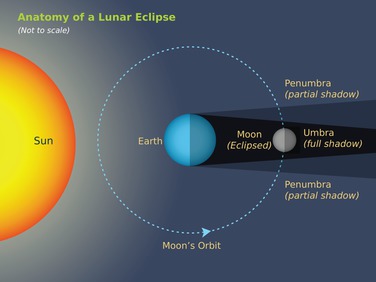Two to four times a year, a full moon passes through Earth's shadow and produces a lunar eclipse. It takes hours to happen, rather than the intense few minutes of a solar eclipse. But the effect can feel quite magical—each time you look up, the familiar moon has changed.
You actually see two shadows in a lunar eclipse, one embedded in the other. Earth's penumbra is a faint shadow on the moon, because not all light from the sun is blocked. The umbra within it is much darker because Earth prevents any direct sunlight from reaching the moon there.
In a total lunar eclipse, the umbra covers the whole disk of the moon. Even so, the moon does not disappear from view. It takes on an orange or copper color from the small amount of sunlight that diffuses through the Earth's atmosphere and reaches the moon's surface.
The atmosphere acts like a prism—as sunlight light passes through, the air separates the light's component colors. It filters out the blues (the color of Earth's sky) and bends the reds into the planet's shadow, where they can reach the moon and be reflected to an observer on Earth.
Unlike a solar eclipse, which is only visible to observers in a narrow line along Earth's surface, a lunar eclipse can be seen by billions of people from anywhere on Earth's night side.
